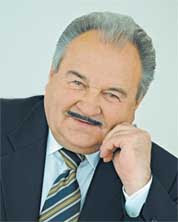بينما ابحث عن بعض مواصفات الرادار
وجدت حوارا قديما للرئيس التنفيذي المسئول عن المشروع يعود تاريخه الى 2009
سانقل الكلام ثم بعد ذلك الاستفسارات
I must say it in no mean was official interview, but he answered for all my questions with pleasure. I was impressed by his openness and friendliness. He explain me, that initially figured 120 km detection range – is highly downplayed, and reflect the real capability of the radar in very initial stage of work, already overcome. According to him, the planned capability of standard flying target detection for Zhuk-AE (with 680 emitting units) is 250 km, and he is in no doubt to achieve it.
Unlike MAKS-2007 this year only 'Zhuk-AE' dummy was displayed. Mr. Kanashchenkov said me it's because all working AESAs are in active flying tests now.
I asked him whether he plans to go to the 'second generation' gallium-nitride technology for MMICs instead of current gallium-arsenide. Gallium-nitride MMICs could give more powerful emission. He answered me, that it would be needed only if the electric power station of contemporary fighters was much more powerful. Now it limits the radar power, not the MMIC's technology. For example, he says, each 'Zhuk-AE's emitting element has 5 watt maximal output. However, now they still use only 3-3.5 watts with more output will be tested in the future. In addition, he explained me, Russian MMIC technology is better in some aspects, than other countries have. Russian MMICs are truly monolithic nanoheterostructures, while other AESA developers use soldered circuits with lesser reliability. Therefore, they also have no intention for 1000 units AESA for MiG-35 variant of the radar because 680 MMICs 'Zhuk-AE' is far from its full capabilities.

In addition, he said they actively work on EW, ELINT and net-centric capabilities of the radar. A popular question was about capability of AESA radar to disseminate computer viruses on enemy radars. He said it could be possible only if the enemy radar has OEM chips with a backdoor 'bug' installed. Then you can just give the command for enemy radar die-out via your AESA.
الان هل يمكن لاحد خبراء المنتدى ان يشرح كيف ان موديولات الرادار الروسي افضل من نظيرتها الغربية (حسب ادعاؤه) وبالتالي يمكن ان يحقق 680 موديول مدى كشف 250 كم لهدف 3 متر مربع ؟ للاسف لم افهم شرحه
وبخصوص الجزء الاخير الملون بالاحمر .. فهل هذا يعني ان موضوع قدرة اعطاب الرادار عن طريق فيروس خامل حقيقية ؟ وبالتالي من الوارد ان تكون امركيا مثلا قد امدتنا بردارت قادرة هي على اعطابها وقتما تشاء ؟ هذا كلام يخرج من شخص مسئول وليس نظريات مؤامرة
http://igorrgroup.blogspot.in/2009/08/some-questions-about-fazotrons-aesa-are.html
وجدت حوارا قديما للرئيس التنفيذي المسئول عن المشروع يعود تاريخه الى 2009
سانقل الكلام ثم بعد ذلك الاستفسارات
I must say it in no mean was official interview, but he answered for all my questions with pleasure. I was impressed by his openness and friendliness. He explain me, that initially figured 120 km detection range – is highly downplayed, and reflect the real capability of the radar in very initial stage of work, already overcome. According to him, the planned capability of standard flying target detection for Zhuk-AE (with 680 emitting units) is 250 km, and he is in no doubt to achieve it.
Unlike MAKS-2007 this year only 'Zhuk-AE' dummy was displayed. Mr. Kanashchenkov said me it's because all working AESAs are in active flying tests now.
I asked him whether he plans to go to the 'second generation' gallium-nitride technology for MMICs instead of current gallium-arsenide. Gallium-nitride MMICs could give more powerful emission. He answered me, that it would be needed only if the electric power station of contemporary fighters was much more powerful. Now it limits the radar power, not the MMIC's technology. For example, he says, each 'Zhuk-AE's emitting element has 5 watt maximal output. However, now they still use only 3-3.5 watts with more output will be tested in the future. In addition, he explained me, Russian MMIC technology is better in some aspects, than other countries have. Russian MMICs are truly monolithic nanoheterostructures, while other AESA developers use soldered circuits with lesser reliability. Therefore, they also have no intention for 1000 units AESA for MiG-35 variant of the radar because 680 MMICs 'Zhuk-AE' is far from its full capabilities.

In addition, he said they actively work on EW, ELINT and net-centric capabilities of the radar. A popular question was about capability of AESA radar to disseminate computer viruses on enemy radars. He said it could be possible only if the enemy radar has OEM chips with a backdoor 'bug' installed. Then you can just give the command for enemy radar die-out via your AESA.
الان هل يمكن لاحد خبراء المنتدى ان يشرح كيف ان موديولات الرادار الروسي افضل من نظيرتها الغربية (حسب ادعاؤه) وبالتالي يمكن ان يحقق 680 موديول مدى كشف 250 كم لهدف 3 متر مربع ؟ للاسف لم افهم شرحه
وبخصوص الجزء الاخير الملون بالاحمر .. فهل هذا يعني ان موضوع قدرة اعطاب الرادار عن طريق فيروس خامل حقيقية ؟ وبالتالي من الوارد ان تكون امركيا مثلا قد امدتنا بردارت قادرة هي على اعطابها وقتما تشاء ؟ هذا كلام يخرج من شخص مسئول وليس نظريات مؤامرة
http://igorrgroup.blogspot.in/2009/08/some-questions-about-fazotrons-aesa-are.html

